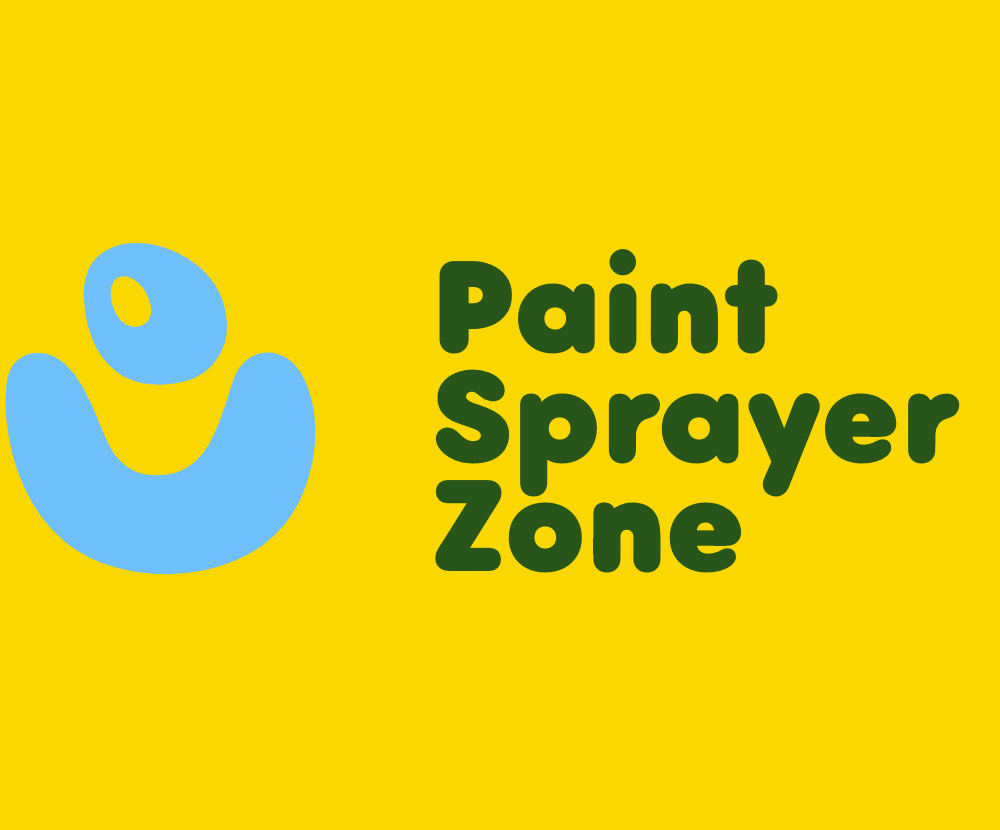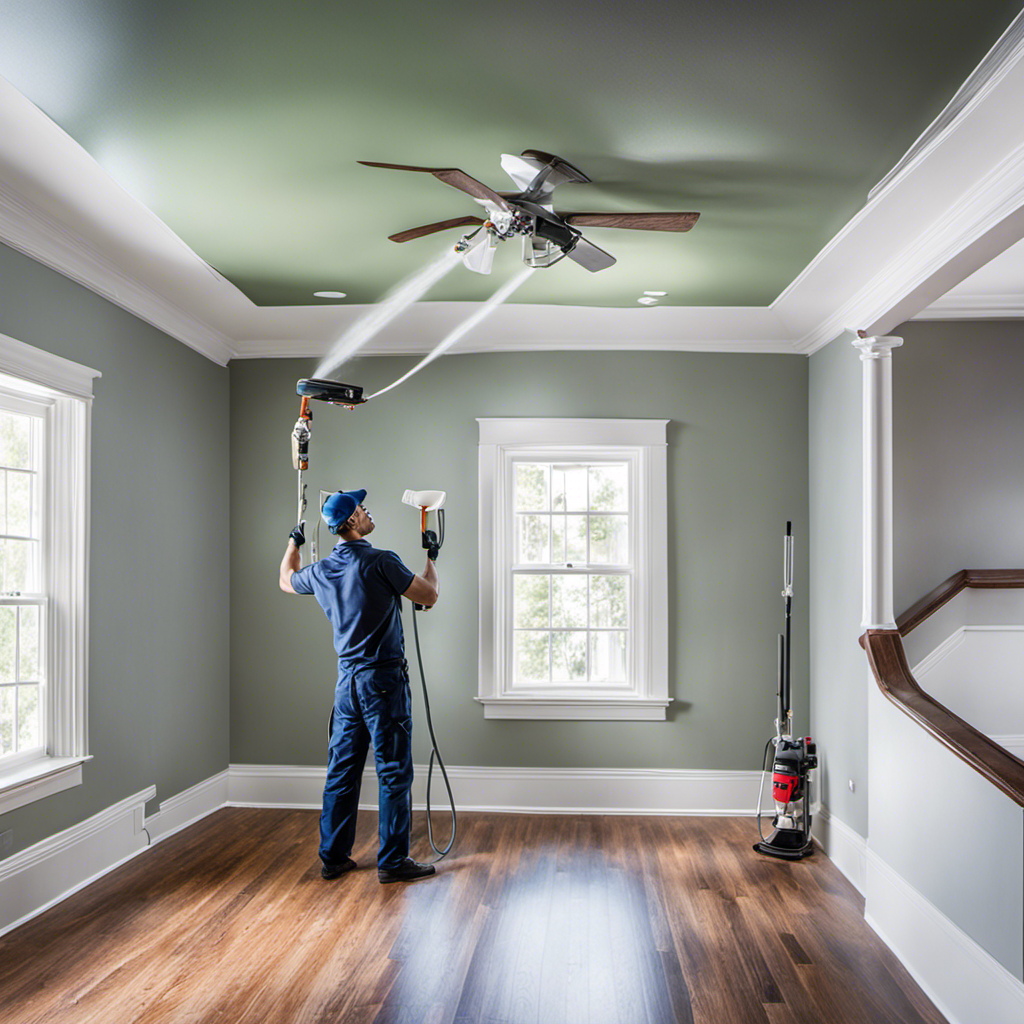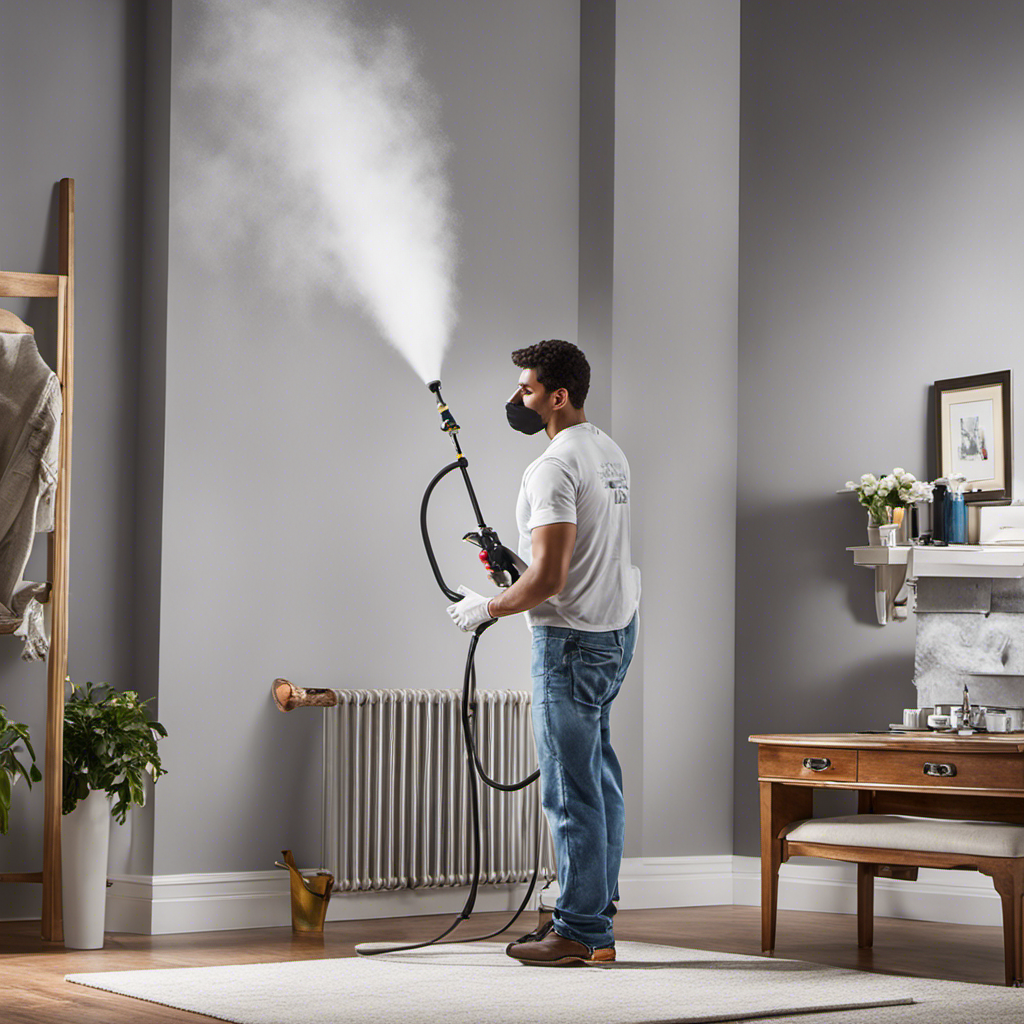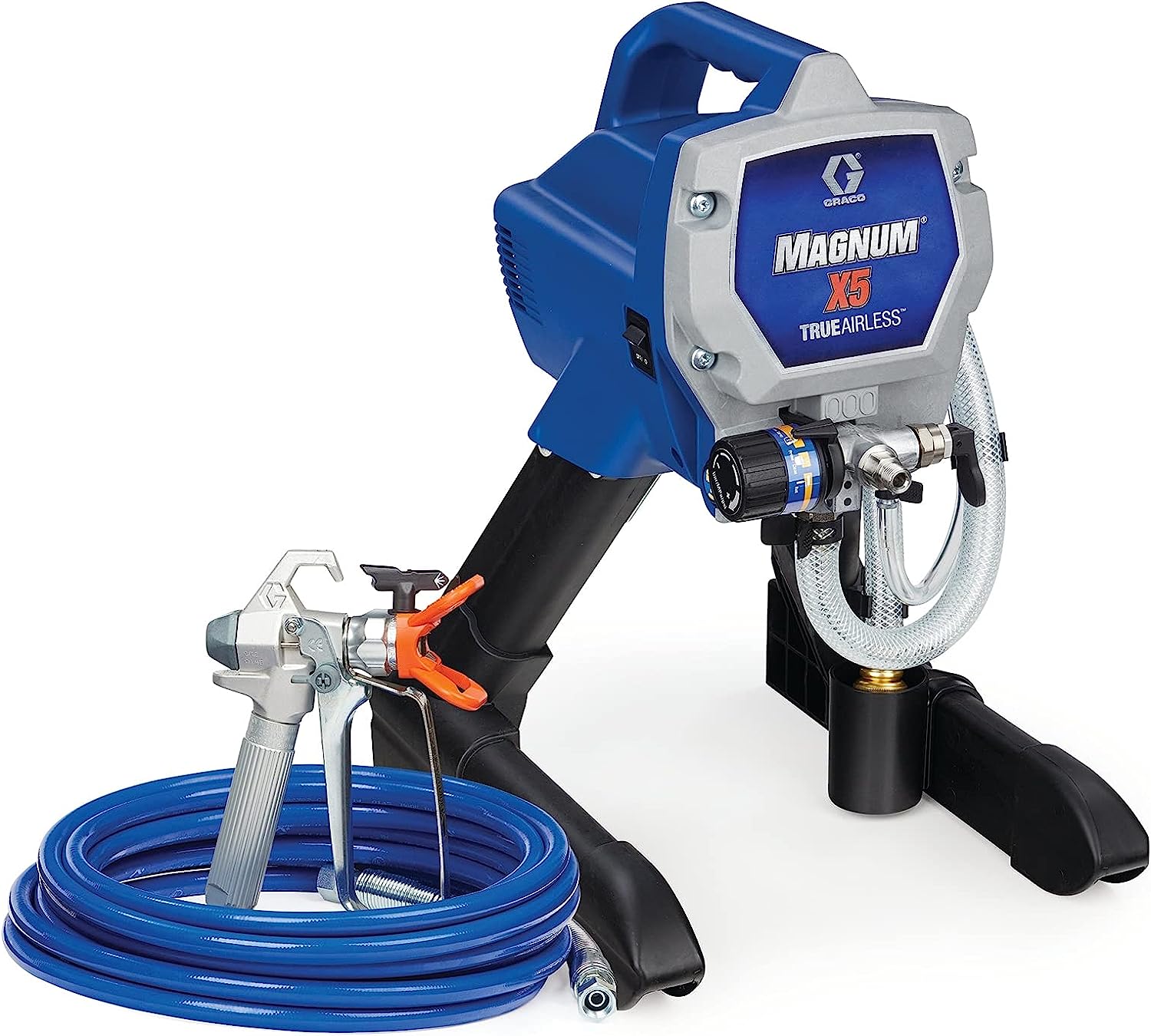Paint Sprayer Maintenance and Troubleshooting
Why Using the Right Oil Matters for Your Airless Paint Sprayer

When it comes to airless paint sprayers, selecting the right oil is vital for their best performance and longevity. It’s important to properly maintain and store the oil to prevent the equipment from malfunctioning and unnecessary wear and tear.
The viscosity of the oil greatly influences the spray patterns and coverage, making it vital to select the correct viscosity to avoid clogs and reduced efficiency. By adhering to manufacturers’ guidelines and ensuring regular lubrication, one can optimize their airless paint sprayer’s functioning.
Storing the oil appropriately is also crucial to prevent degradation.
Key Takeaways
- Using the right oil is crucial for optimal functioning and performance of an airless paint sprayer.
- Different types of oil are available that are specifically designed for high pressures and temperatures of airless paint sprayers.
- Viscosity of the oil affects spray patterns and coverage, so understanding viscosity is important for achieving desired results.
- Proper oil maintenance and storage, including regular checks, top-ups, and following manufacturers’ guidelines, ensures effective functioning and longevity of the sprayer.
The Importance of Using the Right Oil
Using the right oil in an airless paint sprayer is crucial for optimal performance and longevity. The role of oil in equipment malfunction cannot be understated. By using low-quality or contaminated oil, users risk clogs and decreased performance.
Regular lubrication with the appropriate oil prevents wear and tear, ensuring the sprayer functions smoothly and efficiently. Neglecting oil maintenance can lead to clogs and inconsistent spray patterns, resulting in subpar paint application.
To avoid these issues, it is important to choose the right oil for airless paint sprayers. Using the wrong oil can lead to clogs and decreased performance. Different types of oil are available that complement airless paint sprayers, providing the necessary lubrication and protection.
Proper Oil Maintenance and Storage
Proper maintenance and storage of the oil is crucial for ensuring optimal functioning of the airless paint sprayer. Preventing oil degradation and extending sprayer longevity are key objectives.
To achieve this, it is important to store oil in a cool and dry place to prevent degradation. Regularly checking and topping up oil levels is essential for optimal performance. Following the manufacturer’s guidelines for oil change intervals is also important.
It is recommended to use high-quality oil specifically designed for airless paint sprayers. This ensures proper lubrication and prevents clogs, resulting in effective functioning.
The Role of Oil in Equipment Malfunction
Improper oil maintenance can lead to equipment malfunction in airless paint sprayers. The role of oil in equipment malfunction is significant as it plays a crucial part in preventing clogs and ensuring optimal performance.
Using the wrong oil or neglecting oil maintenance can result in decreased performance and inconsistent spray patterns. Clogs can occur when the oil fails to lubricate the necessary components, leading to blockages in the sprayer system. This can cause the sprayer to malfunction and result in reduced efficiency.
To avoid these issues, it is important to use the correct oil designed for airless paint sprayers and follow the manufacturer’s recommendations for oil change intervals. Proper oil maintenance is essential for preventing clogs and ensuring consistent, reliable performance.
Regular Lubrication for Preventing Wear and Tear
Regularly lubricating the necessary components of an airless paint sprayer helps prevent wear and tear, ensuring its longevity and optimal performance. Proper oil maintenance is essential for regular maintenance, and choosing the right oil is crucial for the sprayer’s efficiency. When selecting oil for an airless paint sprayer, it is important to consider factors such as viscosity and compatibility. Different types of oil are available that complement airless paint sprayers, but it is crucial to use oil specifically designed for high pressures and temperatures. Using the wrong oil can lead to clogs and decreased performance. Regularly checking and topping up oil levels, following manufacturers’ guidelines for oil change intervals, and using high-quality oil designed for airless paint sprayers are all part of proper oil maintenance and storage. By ensuring proper lubrication and preventing clogs, the airless paint sprayer can function effectively and provide optimal results.
| Point | Details |
|---|---|
| Regular Maintenance | Regularly lubricate necessary components |
| Oil Selection | Choose oil designed for high pressures and temperatures |
| Proper Lubrication | Ensure optimal performance and prevent clogs |
The Impact of Neglecting Oil Maintenance
Neglecting proper oil maintenance and storage can have a detrimental impact on the efficiency and performance of an airless paint sprayer. The consequences of poor oil maintenance can lead to various issues that affect the overall functionality of the equipment.
Here are some key points to consider regarding the impact of oil neglect and the consequences of poor oil maintenance:
- Increased risk of equipment malfunction and breakdown
- Reduced spray quality and inconsistent patterns
- Clogging of the spray gun and nozzle
- Decreased lifespan of the airless paint sprayer
- Inefficient use of paint and increased material waste
To avoid these issues, it is crucial to prioritize oil maintenance. Regularly check and top up oil levels, follow manufacturers’ guidelines for oil change intervals, and use high-quality oil designed specifically for airless paint sprayers.
Proper oil maintenance and storage ensure optimal performance and longevity of your equipment.
Types of Oil Compatible With Airless Paint Sprayers
Different oil types specifically designed for high pressures and temperatures are compatible with airless paint sprayers. These oils are essential for ensuring optimal performance and longevity of the equipment. When it comes to airless paint sprayers, using the wrong oil can lead to clogs and decreased performance. Therefore, it is crucial to choose the right oil that complements the sprayer’s requirements.
Viscosity plays a significant role in sprayer performance, affecting how easily the paint flows and influencing spray patterns and coverage. Different paint formulations have varying viscosities, and temperature also affects viscosity. By understanding viscosity and using the correct oil, users can achieve optimal spray patterns and coverage.
It is important to follow the manufacturer’s recommendations and choose the appropriate oil to prevent clogging and maintain efficiency.
Avoiding Clogs and Decreased Performance
To prevent clogs and maintain optimal performance, users should ensure proper lubrication and follow the manufacturer’s guidelines for oil change intervals.
Neglecting oil maintenance can lead to clogs and decreased performance, resulting in inconsistent spray patterns and reduced efficiency.
By using the correct oil viscosity, users can avoid clogs and improve spray quality. Choosing the right viscosity is crucial, as using the wrong viscosity can lead to clogging and reduced efficiency.
Additionally, high-quality oil with the right additives enhances sprayer longevity and ensures optimal performance.
Proper oil maintenance and storage are essential for preventing clogs and maintaining effective functioning. Regularly checking and topping up oil levels, storing oil in a cool, dry place, and using high-quality oil designed for airless paint sprayers are all important steps in avoiding clogs and improving spray quality.
Choosing the Right Oil for Optimal Performance
Proper maintenance and storage of oil is crucial in order to achieve optimal performance with an airless paint sprayer. Choosing the right oil viscosity and preventing oil degradation are key factors in ensuring the longevity and efficiency of the equipment.
Using the wrong viscosity can lead to clogs and reduced efficiency, resulting in inconsistent spray patterns and decreased coverage. It is important to select oil that matches the manufacturer’s recommendations, as airless paint sprayers require specific oil designed for high pressures and temperatures.
Regular lubrication with the appropriate oil prevents wear and tear, enhancing the sprayer’s performance and longevity. To prevent oil degradation, store the oil in a cool, dry place and follow the manufacturer’s guidelines for oil change intervals.
Understanding Viscosity and Its Impact
In order to fully understand why using the right oil matters for your airless paint sprayer, it is important to delve into the concept of viscosity and its impact on sprayer performance. Viscosity refers to how easily a liquid flows, and it plays a crucial role in determining how well the paint is sprayed.
Different paint formulations have varying viscosities, and understanding this factor is essential for achieving optimal spray patterns and coverage.
Additionally, the consistency of the paint is also affected by viscosity. The right oil can help maintain the desired paint consistency, ensuring smooth and even application. This is where the role of additives in oil performance comes into play.
Additives are specifically designed to enhance the performance of the oil and provide additional benefits such as improved lubrication and protection against wear and tear.
Viscosity and Spray Patterns
Understanding viscosity and its impact on spray patterns is crucial for achieving optimal performance with an airless paint sprayer. Viscosity refers to the thickness or resistance to flow of a liquid. When it comes to paint, viscosity determines how easily it flows through the sprayer and onto the surface being painted.
Proper oil selection plays a critical role in maintaining the desired viscosity for efficient paint flow. Using the right oil ensures that the sprayer operates smoothly and consistently, preventing clogs and disruptions in the spray pattern. In addition, choosing the correct oil enhances the durability of the sprayer by providing adequate lubrication to the internal components.
Temperature and Viscosity Relationship
The temperature of the environment directly affects the viscosity of the paint, which ultimately impacts the spray patterns and coverage achieved by the airless paint sprayer.
When the temperature increases, the viscosity of the paint decreases, resulting in a thinner consistency. This allows the paint to flow more easily through the sprayer, leading to wider spray patterns and better coverage.
On the other hand, when the temperature decreases, the viscosity of the paint increases, causing it to become thicker. This can result in more concentrated spray patterns and potentially uneven coverage.
Therefore, it is important to consider the temperature when using an airless paint sprayer to ensure the paint flows properly and the desired spray coverage is achieved.
Benefits of Using the Correct Oil
Choosing the appropriate oil viscosity ensures optimal performance and longevity of the sprayer. Using high-quality oil provides several benefits for airless paint sprayers.
Firstly, it ensures longevity by reducing wear and tear on the equipment. High-quality oil with the right additives enhances the sprayer’s lifespan and prevents premature breakdown.
Additionally, using the correct oil viscosity improves overall performance. It minimizes the risk of clogs and reduces the chances of reduced efficiency. The sprayer operates smoothly and consistently, resulting in better spray patterns and coverage.
Clogging and Efficiency Issues
Clogs and reduced efficiency can occur when the wrong viscosity is used in an airless paint sprayer. To prevent these issues and maximize efficiency, it is crucial to choose the correct viscosity oil for the sprayer. Here are five important points to consider:
- Using the wrong viscosity oil can lead to clogs, which can disrupt the paint flow and cause uneven spray patterns.
- The right viscosity oil ensures smooth operation and consistent paint application, maximizing the sprayer’s efficiency.
Regular maintenance, including checking and topping up oil levels, helps prevent clogs and ensures optimal performance.
Following the manufacturer’s recommendations for oil change intervals and using high-quality oil designed for airless paint sprayers is essential for preventing clogs.
Proper lubrication with the correct viscosity oil is necessary to prevent wear and tear, prolong the sprayer’s lifespan, and maintain optimal efficiency.
Proper Oil Maintenance and Storage Tips
Proper oil maintenance and storage techniques are essential for preventing oil degradation and ensuring optimal performance of your airless paint sprayer. By following these practices, you can prolong the life of your equipment and avoid costly repairs. Here are some tips for proper oil maintenance and storage:
| Proper Oil Maintenance and Storage Tips |
|---|
| Store oil in a cool and dry place to prevent degradation caused by heat and moisture. |
| Regularly check and top up oil levels to ensure optimal performance. |
| Follow the manufacturer’s guidelines for oil change intervals to maintain the sprayer’s efficiency. |
| Use high-quality oil specifically designed for airless paint sprayers to enhance longevity and performance. |
Frequently Asked Questions
Can I Use Any Type of Oil in My Airless Paint Sprayer?
Using the wrong oil in an airless paint sprayer can damage the machine and affect its performance, so it’s important to use the right type of oil.
Different types of oil are available that complement airless paint sprayers, designed specifically for high pressures and temperatures.
Using the correct oil viscosity is crucial for optimal performance, as using the wrong viscosity can lead to clogging and reduced efficiency.
It’s essential to choose oil that matches the manufacturer’s recommendations to ensure optimal spray patterns and coverage.
How Does Viscosity Affect the Performance of an Airless Paint Sprayer?
Oil viscosity has a significant impact on the performance of an airless paint sprayer. Using the correct viscosity is crucial for optimal functioning.
If the viscosity is too high, the paint may not flow smoothly, resulting in clogs and reduced efficiency.
On the other hand, if the viscosity is too low, the spray pattern may become inconsistent and the coverage may be uneven.
It is essential to choose the right oil viscosity to ensure reliable and effective operation of the airless paint sprayer.
What Happens if I Use the Wrong Viscosity Oil in My Sprayer?
Using the wrong viscosity oil in an airless paint sprayer can have detrimental effects. The potential oil damage includes clogs, reduced efficiency, and increased wear and tear on the equipment.
It is crucial to understand the importance of oil viscosity in maintaining optimal performance. Proper lubrication with the correct viscosity oil ensures smooth flow, consistent spray patterns, and maximum coverage.
Neglecting this aspect can lead to costly repairs and compromised results.
How Often Should I Check and Top up the Oil Levels in My Sprayer?
To properly clean and maintain your airless paint sprayer, it’s important to regularly check and top up the oil levels. This ensures optimal performance and prevents clogs.
Using a high-quality oil designed for airless paint sprayers is crucial for the longevity of your equipment. The benefits of using the right oil include enhanced efficiency, reduced clogging, and increased sprayer lifespan.
Following the manufacturer’s guidelines for oil change intervals and proper lubrication will ensure effective functioning of your sprayer.
Can I Store My Oil in Any Location, or Are There Specific Storage Requirements?
Proper storage conditions for oil are essential to maintain the integrity and performance of your airless paint sprayer. Storing oil in a cool, dry place prevents degradation and ensures its effectiveness when used.
Using the wrong oil can damage your sprayer, causing clogs and reduced efficiency. It’s crucial to follow the manufacturer’s recommendations and use high-quality oil specifically designed for airless paint sprayers.
Conclusion
In conclusion, the choice of oil for an airless paint sprayer is not to be taken lightly. Symbolically, it represents the lifeblood of the equipment, ensuring its optimal performance and longevity.
Neglecting proper oil maintenance and storage would be akin to denying nourishment to the sprayer, leading to equipment malfunction and wear and tear.
By understanding viscosity and the relationship between temperature and oil flow, one can achieve superior spray patterns and coverage.
Ultimately, using the correct oil, combined with regular lubrication and diligent storage, is essential for the effective functioning and maintenance of an airless paint sprayer.
Drenched in creativity and armed with a fountain pen, Isolde weaves words as gracefully as a painter strokes their canvas. A writer for Paint Sprayer Zone, her passion for colors, textures, and spaces finds a harmonious blend with her profound knowledge of painting tools and techniques.
Having grown up in a family of artists, Isolde’s tryst with paints began early. While her relatives expressed themselves on canvas, Isolde found her medium in words. She dedicated herself to chronicling the world of painting, understanding the nuances of each tool, and the artistry behind every spritz of a paint sprayer.
Paint Sprayer Maintenance and Troubleshooting
Maximize Your Airless Paint Sprayer’s Lifespan With These Essential Tips
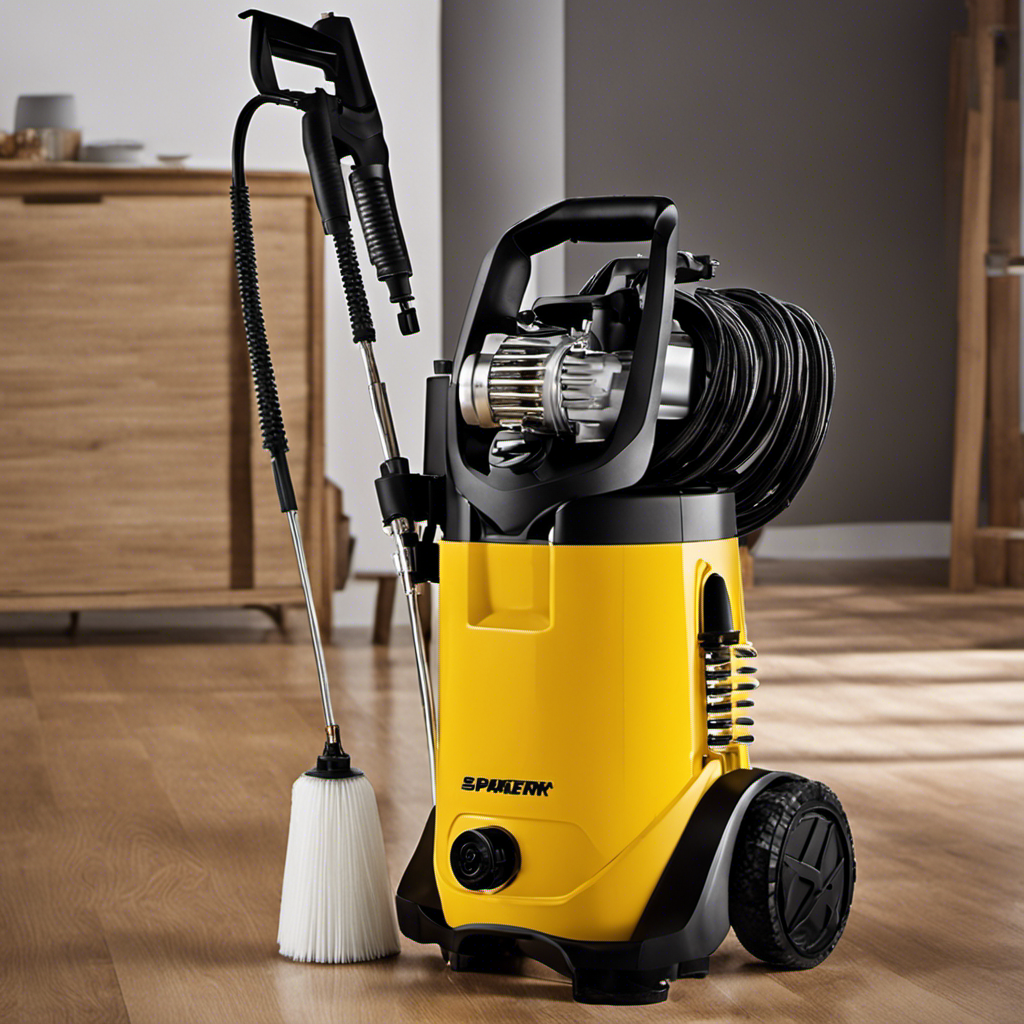
Are you fed up with your paint sprayer malfunctioning when you need it the most? No need to fret, we’ve got your back!
In this article, we’ll provide you with essential tips to maximize the lifespan of your airless paint sprayer. Imagine a paint sprayer that lasts longer, performs reliably, and saves you time and money.
By following these simple yet effective techniques, you’ll ensure proper storage, regular cleaning, and maintenance, and the use of high-quality replacement parts.
So, let’s dive in and make your airless paint sprayer last for years to come!
Key Takeaways
- Proper storage and protection: Clean and dry the sprayer before storage, find a cool and dry place, invest in a protective case, and keep it away from extreme temperatures and moisture.
- Regular cleaning: Clean the spray gun after each use, check and clean the filters regularly, flush out the system, and keep the storage area clean to prevent clogs and blockages.
- Lubrication: Follow manufacturer’s recommendations for oil type and usage, regularly check oil levels, and apply oil to moving parts for smooth operation.
- High-quality replacement parts: Invest in durable and reputable replacement parts, replace worn-out or damaged parts promptly, and use genuine parts to maintain performance and reliability.
Proper Storage and Protection
To maximize your airless paint sprayer’s lifespan, follow these steps:
- Clean the sprayer thoroughly before storage. Ensure all components are dry.
- Find a cool and dry place to store the sprayer.
- Proper sprayer maintenance and effective storage techniques are crucial for keeping your equipment in optimal condition.
After each use:
- Clean the spray gun and check and clean the filters regularly.
- Flush out the entire system with water or a cleaning solution to prevent clogs and blockages.
- Lubricate the sprayer with the manufacturer-recommended oil to reduce friction, wear, and corrosion.
Remember to:
- Invest in high-quality replacement parts to ensure durability and functionality.
- Cheap parts wear out quickly and require frequent replacements.
Thorough Cleaning
Regularly clean the spray gun after each use to prevent clogs and maintain optimal performance. Thorough cleaning techniques are essential to ensure the longevity of your airless paint sprayer.
Start by disassembling the spray gun and removing any paint residue or debris. Use a cleaning solution recommended by the manufacturer and thoroughly clean all the components, including the nozzle and filter.
Pay close attention to the hoses, as they can also become clogged with dried paint. Flush out the entire system with water or the appropriate cleaning solution to ensure all paint particles are removed.
After cleaning, dry all the components thoroughly before reassembling the spray gun. By following these thorough cleaning techniques and using the best cleaning solutions, you can keep your airless paint sprayer in optimal condition and avoid any performance issues.
Regular Filter Maintenance
Ensure you clean and inspect the filters of your airless paint sprayer on a consistent basis to maintain optimal performance. Cleaning the filters regularly is essential to prevent clogs and ensure smooth operation.
The frequency of cleaning will depend on the type and amount of paint being sprayed. As a general rule, it’s recommended to clean the filters after every use or at least once a week for heavy use.
Start by removing the filters from the sprayer and rinse them thoroughly with water or a cleaning solution. Use a soft brush or toothbrush to remove any stubborn debris. Allow the filters to dry completely before reinserting them into the sprayer.
Regularly checking and cleaning the filters will prolong the lifespan of your airless paint sprayer and ensure consistent, high-quality results.
Flushing the System
Flushing the system is an important step in maintaining the performance of your airless paint sprayer. Regular system maintenance ensures optimal performance and prevents clogs or blockages.
To flush the system, start by removing any remaining paint from the sprayer. Then, fill the paint container with a cleaning solution recommended by the manufacturer.
Attach the sprayer to a water source and turn it on. Allow the cleaning solution to flow through the system, flushing out any paint residue or debris. Run the cleaning solution through all components, including the hoses, filters, and nozzle.
Once the cleaning solution runs clear, disconnect the sprayer from the water source and thoroughly rinse the system with clean water.
This flushing technique will help maintain the efficiency and longevity of your airless paint sprayer.
Clean Storage Area
To maintain the cleanliness of your storage area, keep it free from dust or dirt that could potentially enter critical components. Here are some cleaning techniques and tips to prevent dust accumulation:
- Regularly dust and sweep the storage area to remove any loose dirt or debris.
- Use a vacuum cleaner with a brush attachment to clean hard-to-reach areas.
- Wipe down surfaces with a damp cloth to remove any stubborn dust or grime.
- Consider using air purifiers or dehumidifiers to maintain a clean and dry environment.
Store your airless paint sprayer in a protective case or bag to prevent dust from settling on it. Avoid storing the sprayer in areas prone to moisture or dust, such as basements or garages. Cover the sprayer with a cloth or plastic sheet when not in use to further protect it from dust.
Nozzle and Filter Cleaning
Now that you understand the importance of keeping your storage area clean, let’s move on to the next crucial aspect of maintaining your airless paint sprayer: nozzle and filter cleaning.
Regularly cleaning the nozzle and filters is essential for optimal performance and preventing common nozzle issues.
To start, always follow the manufacturer’s instructions for cleaning the nozzle. Typically, this involves removing the nozzle from the spray gun and soaking it in a cleaning solution or using a specialized cleaning brush to remove any paint residue or debris. Be sure to clean the nozzle thoroughly, as any build-up can lead to clogs or uneven spray patterns.
Additionally, it’s crucial to regularly check and clean the filters. These filters help prevent debris from entering the sprayer and can become clogged over time. Simply remove the filters and rinse them with water or a cleaning solution, ensuring all dirt and debris are removed.
Hose Inspection and Cleaning
Make sure you regularly inspect and clean the hoses of your airless paint sprayer to ensure optimal performance. Here are some troubleshooting tips for hose maintenance:
- Check for any cracks or leaks in the hoses
- Inspect the hose fittings for any signs of wear or damage
- Clean the hoses thoroughly after each use to remove any paint residue or debris
- Use a soft brush or cloth to clean the exterior of the hoses
- Flush out the hoses with water or a cleaning solution to remove any clogs or blockages
- Pay attention to any kinks or twists in the hoses and straighten them out if necessary
- Replace any damaged or worn-out hoses promptly to prevent further issues
- Store the hoses in a clean and dry area to prevent them from being exposed to moisture or dust
Lubrication Guidelines
Ensure you consult the manufacturer’s recommendations for the correct oil type to use in your airless paint sprayer. Using the right oil is crucial for optimal performance and longevity. Lightweight mineral-based oil designed for high-pressure applications is typically recommended.
Regularly check the oil level in your sprayer and top up or change the oil as recommended by the manufacturer. Following the proper oiling frequency is important to reduce friction, wear, and corrosion. Apply oil to moving parts to ensure smooth operation, but be cautious not to over-lubricate as it can attract dust and debris.
Regularly check oil levels and refill as needed to maintain the sprayer’s efficiency. By using the appropriate oil and following the recommended lubrication frequency, you can maximize the lifespan of your airless paint sprayer.
Correct Oil Type
Using the recommended lightweight mineral-based oil for high-pressure applications is crucial to ensure optimal performance and longevity of your airless paint sprayer. Choosing the right oil and proper lubrication techniques are essential for maintaining your sprayer.
Here are some key points to consider:
- Use a lightweight mineral-based oil designed for high-pressure applications.
- Regularly check the oil level in the sprayer and top up or change it as recommended.
- Proper oil usage reduces friction, wear, and corrosion in the internal components.
- Apply oil to the moving parts to ensure smooth operation.
- Avoid over-lubricating, as it can attract dust and debris.
- Follow the manufacturer’s guidelines for oiling frequency.
- Regularly check oil levels and refill as needed.
Regular Oil Level Check
Check the oil level in your sprayer regularly to ensure optimal performance and prevent unnecessary wear and tear.
Regular oil level monitoring is crucial for maintaining the efficiency of your airless paint sprayer. Oil acts as a lubricant, reducing friction and preventing corrosion within the internal components.
By regularly checking the oil level and topping up or changing it as recommended by the manufacturer, you can ensure smooth operation and extend the lifespan of your sprayer.
Regular oil changes are important because over time, the oil can become contaminated with debris and lose its lubricating properties. By staying on top of oil changes, you can prevent damage to the sprayer and avoid costly repairs.
Make it a habit to monitor the oil level in your sprayer and perform regular oil changes to keep it running smoothly.
High-Quality Replacement Parts
When it comes to maintaining your airless paint sprayer, using high-quality replacement parts is essential. Genuine parts offer several benefits that can significantly impact the lifespan and performance of your sprayer.
Here are some reasons why using genuine parts is important:
-
Superior Durability and Functionality:
- Genuine parts are designed specifically for your sprayer model, ensuring a perfect fit and optimal performance.
- They are made from high-quality materials, making them more durable and resistant to wear and tear.
- Using genuine parts eliminates the risk of leaks or malfunctions, providing a reliable and efficient spraying experience.
-
Reduced Repairs and Downtime:
- High-quality replacement parts minimize the need for frequent repairs, saving you time and money.
- Genuine parts are less likely to fail or break, preventing unexpected project delays.
- By investing in genuine parts, you can avoid costly downtime and keep your sprayer working at its best.
-
Maintenance and Reliability:
- Genuine parts are manufactured to meet the highest standards, ensuring consistent performance and reliability.
- Regular maintenance, including the use of genuine replacement parts, is crucial for maximizing the lifespan of your sprayer.
- By following recommended maintenance practices and using genuine parts, you can enjoy a reliable and long-lasting airless paint sprayer.
Importance of Premium Parts
Investing in high-quality replacement parts for your airless paint sprayer is essential for durability and optimal performance. Premium parts offer several benefits. Firstly, they are designed to fit and function perfectly, eliminating leaks or malfunctions that can occur with cheaper alternatives. Additionally, premium parts have a longer lifespan, reducing the need for frequent replacements. When choosing replacement parts, consider reputable manufacturers who offer warranties for their products. Ensure that the replacement parts are compatible with your specific sprayer model. Using genuine parts is crucial to maintain performance and reliability. By investing in high-quality replacement parts, you can minimize repairs, extend the lifespan of your sprayer, and ultimately save time and money in the long run.
Reputable Manufacturers for Replacement Parts
Look for warranties provided by reputable manufacturers to ensure the quality and reliability of replacement parts for your airless paint sprayer.
When it comes to finding reliable suppliers for replacement parts, here are a few things to consider:
-
Warranty coverage: Reputable manufacturers often offer warranties on their replacement parts, giving you peace of mind and assurance that the parts are of high quality and built to last.
-
Reputation: Look for manufacturers with a strong reputation in the industry. Reliable suppliers are known for producing top-notch replacement parts that meet or exceed industry standards.
-
Compatibility: Ensure that the replacement parts you choose are compatible with your specific airless paint sprayer model. Reputable manufacturers provide detailed information about compatibility to help you make the right choice.
Timely Replacement of Worn-Out Parts
To ensure optimal performance, regularly replacing worn-out parts is crucial for keeping your airless paint sprayer running smoothly. Timely replacement of worn-out parts is essential for the proper functioning of your sprayer and to avoid any potential breakdowns during your painting projects.
By replacing worn-out parts in a timely manner, you can prevent further damage to your sprayer and ensure its longevity. Not only does timely replacement of parts help maintain the performance of your sprayer, but it also has numerous maintenance benefits. It reduces the risk of malfunctions, leaks, and inefficient paint application. Additionally, it minimizes the need for costly repairs and downtime, saving you both time and money.
Cost and Time Savings With Proper Maintenance
To ensure maximum longevity and performance from your airless paint sprayer, regular maintenance is crucial. By investing a little time and effort into proper care, you can save yourself both money and time in the long run.
Here are the key reasons why regular maintenance is important and the benefits of investing in a protective case:
-
Importance of Regular Maintenance:
- Prevents clogs and blockages, ensuring smooth operation and consistent spray patterns.
- Reduces friction, wear, and corrosion, extending the lifespan of your sprayer.
- Protects the sprayer from cold-related issues, such as freezing or damage to seals and valves.
-
Benefits of Investing in a Protective Case:
- Shields the sprayer from accidental drops, bumps, and impacts.
- Guards against dust, moisture, and other environmental factors that can damage critical components.
- Provides convenient storage and organization for accessories and spare parts.
Frequently Asked Questions
How Often Should I Clean the Spray Gun After Each Use?
To ensure optimal performance, clean the spray gun after each use. This is a crucial step in airless paint sprayer maintenance. Use a cleaning solution recommended by the manufacturer and thoroughly clean all components, including the nozzle and filter.
Regular cleaning prevents clogs and blockages, ensuring smooth operation. By following best practices for cleaning your airless paint sprayer, you can maximize its lifespan and avoid costly repairs.
Can I Use Any Type of Oil for Lubricating the Airless Paint Sprayer?
Yes, you can use any type of oil for lubricating your airless paint sprayer. However, it is important to use the correct oil recommended by the manufacturer for optimal performance and lifespan.
Using the wrong type of oil can lead to friction, wear, and corrosion, causing damage to the internal components. Avoid common mistakes in lubricating airless paint sprayers by consulting the manufacturer’s guidelines and using lightweight mineral-based oil designed for high-pressure applications.
Regularly check the oil level and refill as needed to ensure smooth operation.
How Frequently Should I Check and Clean the Filters?
To extend the lifespan of your airless paint sprayer, it’s important to regularly check and clean the filters. This ensures optimal performance and prevents clogs and blockages. The frequency of checking and cleaning the filters depends on the usage and the type of paint being sprayed.
However, as a general guideline, it is recommended to check and clean the filters after every use or at least once a week for heavy usage. Proper maintenance of the filters will help maximize the lifespan of your airless paint sprayer.
What Are the Benefits of Using High-Quality Replacement Parts?
Using high-quality replacement parts for your airless paint sprayer offers a multitude of benefits. These durable parts ensure proper functionality, eliminating leaks and malfunctions. By investing in premium parts, you can reduce the need for frequent repairs and project downtime.
This not only saves you time but also money in the long run. High-quality replacement parts extend the lifespan of your sprayer, providing reliable performance and enhancing efficiency. So, opt for reputable manufacturers and genuine parts to maximize the durability and longevity of your airless paint sprayer.
How Can Proper Maintenance of the Airless Paint Sprayer Save Me Money and Time in the Long Run?
Proper maintenance of your airless paint sprayer can save you both time and money in the long run. By ensuring proper storage, you protect the sprayer from damage caused by extreme temperatures, moisture, and dust.
Regular maintenance, such as cleaning the spray gun and filters, prevents clogs and blockages that can lead to costly repairs. Using high-quality replacement parts enhances efficiency and reduces project downtime.
Taking these steps will maximize the lifespan of your airless paint sprayer and provide reliable performance.
Conclusion
So there you have it, with these essential tips, you can maximize the lifespan of your airless paint sprayer and enjoy its reliable performance for years to come.
By properly storing and protecting your sprayer, cleaning it thoroughly after each use, and regularly maintaining the filters and system, you can ensure its longevity.
Investing in high-quality replacement parts from reputable manufacturers and timely replacements of worn-out parts will also contribute to cost and time savings.
So take care of your airless paint sprayer and witness the benefits of proper maintenance firsthand.
Franz came aboard the Paint Sprayer Zone team with a background in both journalism and home renovation. His articulate writing style, combined with a passion for DIY projects, makes him an invaluable asset. Franz has a knack for breaking down technical jargon into easy-to-understand content, ensuring that even the most novice of readers can grasp the complexities of paint sprayers.
Paint Sprayer Maintenance and Troubleshooting
Painting Brick Walls With an Airless Sprayer: a Complete Guide
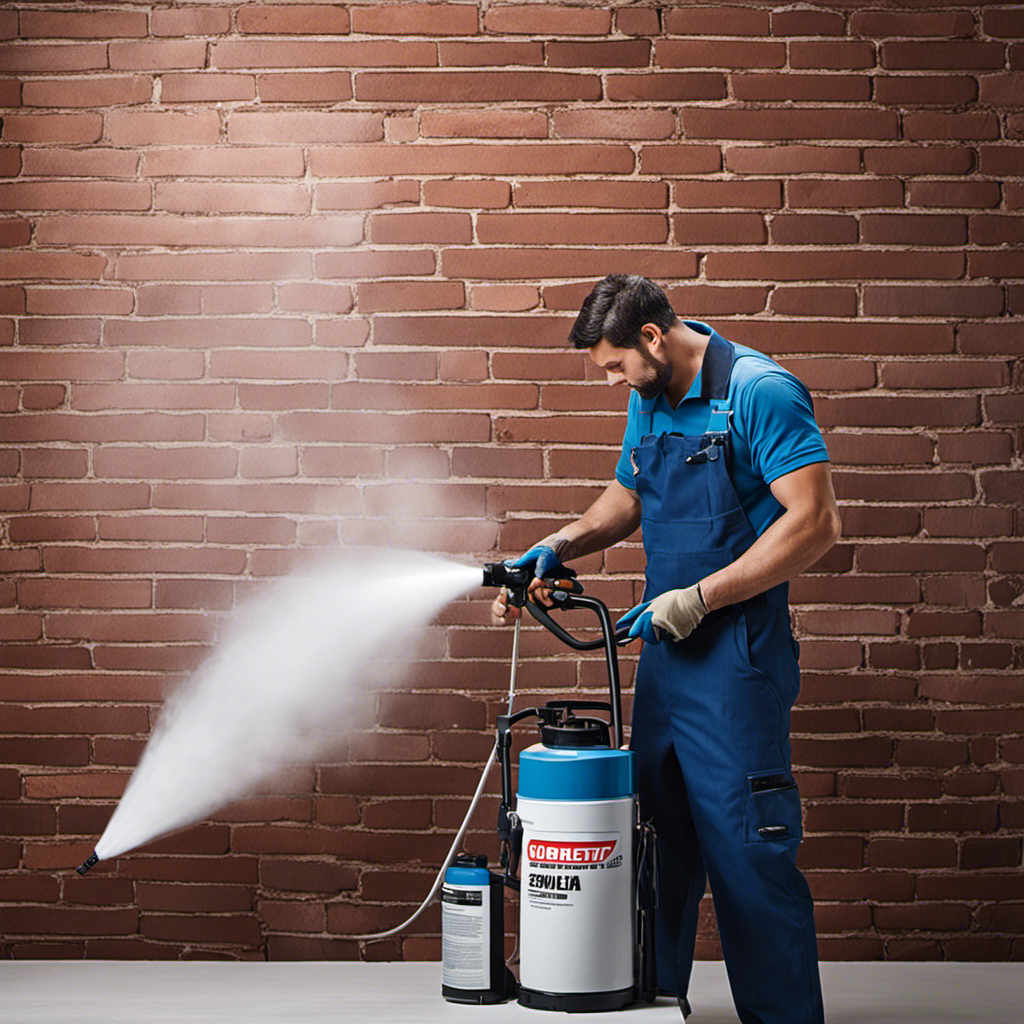
Painting brick walls with an airless sprayer can bring them back to life. This comprehensive guide walks you through every step of the process, from preparing the surface to ensuring an even coat.
With the right tools and materials, including a high-quality primer, you can enhance the durability and resistance of your brick walls. Expert tips and safety precautions ensure a smooth finish and a transformation that will leave your walls looking brand-new.
Get ready to bring new vibrancy and timeless beauty to your space.
Key Takeaways
- Preparation and surface cleaning is essential before painting brick walls with an airless sprayer.
- Selecting the right paint color and gathering the necessary materials and equipment are crucial for a successful painting project.
- Cleaning and maintaining the painted brick walls regularly will help them stay in good condition.
- Priming the walls with a high-quality primer designed for masonry surfaces enhances adhesion, durability, and resistance to moisture and alkali.
Surface Preparation: Tools and Cleaning
The homeowner gathers the necessary tools, including a wire brush, scraper, and power washer, to remove loose paint and dirt from the brick walls. Acquiring these tools is essential for proper cleaning techniques.
Using the wire brush and scraper, the homeowner meticulously removes any loose paint and dirt from the surface of the brick walls. After that, a power washer is used to thoroughly clean the walls, ensuring a clean and smooth surface for painting.
It is important to allow the walls to dry completely before proceeding to the next step. By acquiring the necessary tools and following proper cleaning techniques, the homeowner ensures a clean and well-prepared surface for painting the brick walls.
Selecting the Right Paint Colors and Materials
When selecting paint colors and materials, it is important to consider the desired aesthetic and gather the necessary tools. Choosing paint colors that complement the overall look and feel of the space is crucial for achieving the desired result.
Additionally, having the right materials is essential for a successful painting project. Following a step-by-step guide for surface preparation is also crucial. This includes gathering tools such as a wire brush, scraper, and power washer. It is important to remove loose paint and dirt from the surface using the wire brush and scraper, and then thoroughly clean the area with a power washer.
Once the surface is clean and dry, you can proceed with choosing the appropriate paint color and gathering the necessary materials and equipment like paint, primer, drop cloth, painters tape, and sandpaper.
Essential Equipment for Painting Brick Walls
To achieve a flawless result, one must ensure they have the essential equipment necessary for painting brick walls. This includes proper airless sprayer maintenance and choosing the right paintbrush.
Here are three key items to consider:
-
Well-maintained airless sprayer: Regularly clean and inspect the sprayer to ensure it functions properly. This will ensure consistent paint application and prevent clogging or uneven spraying.
-
High-quality paintbrush: Choose a brush that is suitable for masonry surfaces and the type of paint being used. A good brush will provide smooth and even coverage, allowing for precise detailing and edges.
-
Safety equipment: Protect yourself while painting by wearing safety goggles, gloves, and a mask to prevent inhalation of fumes or particles.
Achieving Even Coverage With an Airless Sprayer
Using an airless sprayer ensures even coverage when painting brick walls. This method is great for achieving consistent results.
However, there are some common issues that may arise when using an airless sprayer. One common issue is overspray, which occurs when the paint is applied too heavily or the sprayer is held too close to the surface. To troubleshoot this issue, adjust the spray nozzle to a narrower setting and maintain a consistent distance from the wall.
Another common issue is clogging of the sprayer tip due to debris or dried paint. To avoid this, strain the paint before pouring it into the sprayer and clean the tip regularly during the painting process.
Proper Technique: Starting From the Top
Starting from the top ensures that the paint is applied evenly and avoids drips or streaks on the brick walls. This technique allows for better control and coverage, ensuring a professional-looking finish.
When starting at the bottom, gravity can cause the paint to run down the wall, leading to uneven application and potential drips. By beginning at the top, the paint can be evenly distributed downwards, avoiding any potential issues.
However, it is important to troubleshoot common issues that may arise when painting brick walls with an airless sprayer. These issues can include clogging of the sprayer nozzle, uneven spray pattern, or overspray.
Cleaning and Maintenance Tips for Painted Brick Walls
Regular cleaning and maintenance is essential for preserving the appearance and longevity of painted brick walls. To keep them looking their best, it’s important to use proper cleaning techniques and know how to remove stubborn stains.
Light dirt can be easily removed with warm water and dish soap. Gently scrub the walls with a soft-bristle brush to avoid damaging the paint.
For stubborn stains, create a solution of white vinegar and water and treat the affected areas. Rinse the walls with clean water to remove any residue.
The Importance of Priming Masonry Surfaces
Priming masonry surfaces is crucial for enhancing adhesion, durability, and resistance to moisture and alkali. A high-quality primer designed for masonry surfaces is essential for paint longevity and a successful painting project.
Without proper priming, paint may not adhere well to the surface, leading to peeling and chipping over time. Primer acts as a barrier, preventing moisture and alkali from seeping into the paint, which can cause it to deteriorate.
However, common issues with primer can occur, such as poor coverage, uneven application, or improper drying. To troubleshoot these problems, ensure the walls are clean and dry before applying primer, use the recommended primer for masonry surfaces, and allow sufficient drying time.
Drying Time for Primer Application
After applying primer to the masonry surfaces, it is important to allow sufficient drying time of approximately 24 hours. This drying time is crucial to ensure that the primer properly adheres to the surface and creates a strong foundation for the paint.
It also allows the primer to fully cure, enhancing its durability and resistance to moisture and alkali. While waiting for the primer to dry, it is essential to protect the surface from any potential damage or contamination.
Additionally, it is worth considering alternative priming methods, such as using a tinted primer or a primer/sealer combination, which can provide additional benefits like improved color coverage or added protection against stains.
Advantages of Primer: Adhesion, Durability, and Resistance
Applying a high-quality primer to masonry surfaces ensures strong adhesion, increased durability, and enhanced resistance to moisture and alkali. The advantages of using primer go beyond these benefits and extend to cost savings, as it helps paint adhere better, reducing the need for multiple coats.
Additionally, primer improves the overall appearance and finish of the painted surface, giving it a smooth and professional look. When it comes to application techniques, primer can be easily applied using a brush, roller, or sprayer, making it suitable for different preferences and skill levels.
Its quick drying time allows for efficient completion of painting projects. Overall, using primer before painting brick walls with an airless sprayer is a wise choice, offering numerous advantages in terms of cost and application techniques.
Expert Tips for a Smooth Paint Finish
To achieve a smooth paint finish on the brick walls, homeowners should consider using a high-quality paint roller for even coverage. This is one of the most important tips for paint application on brick surfaces.
Another common mistake to avoid is using a low-quality roller, which can leave streaks and uneven texture on the walls. It is also essential to choose the right roller nap thickness for the type of brick surface. A thicker nap is typically recommended for rough or textured brick, while a thinner nap works well for smooth brick walls.
Additionally, homeowners should apply the paint in thin, even coats to prevent drips and runs. Taking these tips into consideration can help homeowners achieve a professional-looking smooth paint finish on their brick walls.
Safety Precautions When Using an Airless Sprayer
Using an airless sprayer requires homeowners to wear protective goggles, gloves, and a respirator mask to ensure their safety. The powerful spray of the airless sprayer can create a fine mist of paint particles that can be harmful if inhaled or make contact with the eyes or skin.
To maintain the airless sprayer, regular cleaning is essential to prevent clogs and ensure proper functioning. Troubleshooting common issues like uneven spray pattern or loss of pressure can be resolved by checking for clogs, adjusting the nozzle, or cleaning the filters.
Regular maintenance and troubleshooting will help homeowners achieve a smooth and efficient painting process with their airless sprayer, allowing them to achieve professional-looking results.
The Transformation: Freshly Painted Brick Walls
After taking the necessary safety precautions when using an airless sprayer, the transformation of freshly painted brick walls can be truly remarkable. The impact of color choice cannot be underestimated, as it can completely change the look and feel of a space. Whether it’s a timeless neutral or a bold, vibrant color, a fresh coat of paint can breathe new life into a room. In addition to the aesthetic benefits, there are also practical benefits to consider. Professional painting services can ensure a high-quality finish, saving time and effort for homeowners. They have the expertise to properly prepare the surface, choose the right materials, and apply the paint evenly. The result is a beautifully transformed space that adds value to the home.
| The Impact of Color Choice | Benefits of Professional Painting Services |
|---|---|
| Completely changes the look | High-quality finish |
| and feel of a space | Saves time and effort |
| Timeless or vibrant options | Expertise in surface preparation |
| Adds value to the home | Proper material selection |
| Even application of paint |
Frequently Asked Questions
How Long Does It Typically Take for Brick Walls to Dry Completely After Cleaning?
Brick walls typically take some time to dry completely after cleaning. The drying time can depend on factors such as weather conditions and the level of humidity. However, using the best cleaning methods for brick walls, such as using a power washer and allowing the walls to air dry, can help expedite the drying process.
It is important to ensure that the walls are thoroughly dry before proceeding with any painting or priming to achieve the best results.
Can I Use a Regular Primer on Brick Walls or Is There a Specific Primer for Masonry Surfaces?
When painting brick walls, it’s important to use the right primer for optimal results. While a regular primer may work on some surfaces, there are specific primers designed for masonry surfaces that are recommended for brick walls.
These masonry primers are specially formulated to enhance adhesion, durability, and resistance to moisture and alkali. By choosing the appropriate primer for brick walls, you can ensure better paint adherence and longevity of the paint job.
How Often Should Painted Brick Walls Be Cleaned and Maintained?
Painted brick walls should be cleaned and maintained regularly to keep them looking their best. The cleaning frequency will depend on the level of dirt and grime buildup, but generally, it is recommended to clean them at least once or twice a year.
To maintain the painted surface, homeowners should use warm water and dish soap to remove light dirt and gently scrub the walls with a soft-bristle brush. Stubborn stains can be treated with a solution of white vinegar and water.
Regular cleaning and maintenance will help preserve the appearance and longevity of the painted brick walls.
Is It Necessary to Apply Multiple Coats of Paint for a Smooth Finish?
Applying multiple coats of paint is necessary for achieving a smooth finish on brick walls. Using a roller or brush may not provide the same level of smoothness as an airless sprayer.
The multiple coats allow for better coverage and a more uniform appearance. The airless sprayer ensures even distribution of paint, resulting in a flawless finish.
Are There Any Potential Risks or Dangers Associated With Using an Airless Sprayer for Painting Brick Walls?
Using an airless sprayer for painting brick walls can pose potential risks and dangers. The high-pressure nature of the sprayer can create a fine mist of paint particles, which can be harmful if inhaled. Additionally, there is a risk of overspray, which can result in paint getting on unintended surfaces.
It is important to take safety precautions, such as wearing protective gear and properly ventilating the area. Proper training and experience with using an airless sprayer is also recommended to minimize these risks.
Conclusion
In conclusion, painting brick walls with an airless sprayer can provide a fresh and updated look to any space. It is important to properly prepare the surface by cleaning and removing loose paint and dirt.
Using the right paint colors and materials, along with a high-quality primer, will ensure long-lasting adhesion, durability, and resistance to moisture and alkali. Following the proper technique and safety precautions when using an airless sprayer is crucial.
An interesting statistic to consider is that painting brick walls can increase a home’s value by up to 5%.
Franz came aboard the Paint Sprayer Zone team with a background in both journalism and home renovation. His articulate writing style, combined with a passion for DIY projects, makes him an invaluable asset. Franz has a knack for breaking down technical jargon into easy-to-understand content, ensuring that even the most novice of readers can grasp the complexities of paint sprayers.
Paint Sprayer Maintenance and Troubleshooting
Setting Up and Cleaning the Graco 390 Airless Paint Sprayer

It is essential to properly prepare and maintain the Graco 390 Airless Paint Sprayer to achieve a high-quality paint job. This paint sprayer is efficient and easy to use thanks to its simple setup and user-friendly features. Understanding how to adjust the spray settings using the pressure control knob, spray gun, and hose will help users meet their specific painting requirements.
Additionally, proper cleaning and maintenance ensure the longevity of the paint sprayer. In this article, we will guide you through the step-by-step process of setting up and cleaning the Graco 390 Airless Paint Sprayer, providing you with the knowledge and confidence to achieve outstanding paint results.
Key Takeaways
- Inspect all equipment for good condition before assembly
- Familiarize yourself with adjusting spray pressure for desired coverage
- Regularly clean and maintain the paint sprayer, including the spray gun
- Troubleshoot common issues such as paint viscosity, spray pattern, and clogs in the spray tip
Gathering and Unboxing the Necessary Equipment
The user gathers and unboxes the necessary equipment for setting up the Graco 390 Airless Paint Sprayer. Before starting the setup process, it is important to inspect all the equipment to ensure that everything is in good condition.
This includes checking the paint sprayer unit itself, as well as the spray gun, hose, and any additional accessories that may have been included. The unboxing process involves carefully opening the packaging and removing each component from its protective wrapping. It is important to handle the equipment with care to avoid any damage.
Once all the equipment has been unboxed, the user can proceed to the next step of assembling the components and getting ready for painting.
Assembling the Graco 390 Airless Paint Sprayer
To assemble the Graco 390 Airless Paint Sprayer, simply follow the instructions provided by the manufacturer.
Before starting the assembly process, inspect the components of the sprayer to ensure they are in good condition and nothing is missing. This includes checking the spray gun, hose, and pressure control knob.
Once the inspection is complete, understand how the pressure control works. The pressure control knob allows users to adjust the pressure of the paint being sprayed, which affects the coverage and finish of the paint job. Familiarize yourself with this feature to achieve optimal results with your paint sprayer.
Overall, assembling the Graco 390 Airless Paint Sprayer is a straightforward process that can be easily accomplished by following the manufacturer’s instructions.
Preparing the Surface and Adjusting Spray Settings
After gathering the necessary equipment and materials, the user inspects the surface and cleans it thoroughly before adjusting the spray settings for desired coverage. This is an important step in ensuring a smooth and even paint application.
Preparing the surface involves removing any dirt, dust, or debris that may interfere with the paint adhering properly. This can be done by using a broom, vacuum cleaner, or a damp cloth, depending on the type of surface.
Once the surface is clean, the user can then choose the paint color that best suits their preference and the overall aesthetic they want to achieve. It is important to consider factors such as lighting, room size, and personal taste when selecting paint colors.
Cleaning and Maintaining the Graco 390 Airless Paint Sprayer
In order to ensure optimal performance, it is essential for the user to regularly clean and maintain their Graco 390 Airless Paint Sprayer. Cleaning techniques and a recommended maintenance routine are necessary to keep the sprayer in good working condition.
After each use, it is important to disassemble and clean the spray gun thoroughly. This includes removing any remaining paint and debris from the gun’s components. Additionally, the paint sprayer system should be flushed with a cleaning solution to remove any paint residue.
Proper storage and maintenance of the sprayer is also crucial. This involves storing the sprayer in a clean and dry area, and inspecting it regularly for any signs of wear or damage.
Troubleshooting Common Issues With the Paint Sprayer
The user can check the spray tip for clogs and ensure that the paint viscosity and spray pattern are correct in order to troubleshoot common issues with the paint sprayer. Here are some steps to follow in order to identify and fix paint spray pattern issues:
-
Check paint viscosity: Make sure the paint is properly mixed and thinned according to the manufacturer’s instructions. If the paint is too thick or too thin, it can affect the spray pattern.
-
Inspect the spray pattern: Use a test board or piece of cardboard to spray a test pattern. Look for any irregularities, such as streaks, splotches, or uneven coverage. This can indicate issues with the spray tip or pressure settings.
-
Adjust settings and clean the spray tip: If the spray pattern is not satisfactory, adjust the pressure control knob and clean the spray tip to remove any clogs or debris. A clean spray tip and proper pressure settings are essential for a consistent and even spray pattern.
Frequently Asked Questions
How Long Does It Take to Assemble the Graco 390 Airless Paint Sprayer?
Assembling time for the Graco 390 Airless Paint Sprayer depends on the user’s familiarity with the product. On average, it takes about 10-15 minutes to fully assemble the paint sprayer.
The required tools for assembly include a wrench and screwdriver. Users should carefully follow the instructions provided in the manual to ensure proper assembly and functionality of the sprayer.
What Is the Warranty Period for the Graco 390 Airless Paint Sprayer?
The warranty period for the Graco 390 Airless Paint Sprayer is an important aspect to consider. It provides peace of mind and reassurance to the user.
Additionally, knowing the assembly time required for the paint sprayer can help with planning and scheduling painting projects effectively.
These factors, along with the product’s features and performance, contribute to the overall satisfaction and convenience of using the Graco 390 Airless Paint Sprayer.
Can the Graco 390 Airless Paint Sprayer Be Used With Different Types of Paint?
The Graco 390 Airless Paint Sprayer is compatible with various types of paint, including latex, acrylic, and oil-based paints. This versatility allows users to tackle different painting projects with ease.
The advantages of using the Graco 390 Airless Paint Sprayer with different types of paint include efficient and even coverage, reducing the need for multiple coats. Its high-pressure system ensures excellent paint atomization, resulting in a professional finish.
Overall, the Graco 390 Airless Paint Sprayer is a reliable choice for any painting job.
What Is the Recommended Cleaning Solution for the Graco 390 Airless Paint Sprayer?
The recommended cleaning solution for the Graco 390 Airless Paint Sprayer is a mixture of warm water and a mild detergent. This solution effectively removes any residual paint or debris from the sprayer’s components.
It is important to thoroughly clean the spray gun, hose, and other parts after each use to maintain optimal performance. By following proper cleaning techniques and using the recommended cleaning solution, users can ensure the longevity and efficiency of their Graco 390 Airless Paint Sprayer.
How Often Should the Spray Gun of the Graco 390 Airless Paint Sprayer Be Cleaned?
The spray gun of the Graco 390 Airless Paint Sprayer should be cleaned regularly to ensure optimal performance. Cleaning the spray gun helps troubleshoot common issues such as clogs and improper spray patterns.
It is recommended to clean the spray gun after each use to prevent paint residue from building up and affecting the quality of the spray. By maintaining the spray gun properly, users can extend the lifespan of their Graco 390 Airless Paint Sprayer and achieve consistent, professional results.
Conclusion
In conclusion, setting up and cleaning the Graco 390 Airless Paint Sprayer is an essential task for achieving professional paint finishes. Following the step-by-step guide and familiarizing oneself with the equipment ensures smooth operation and efficient painting.
A clean and well-maintained paint sprayer saves time and money in the long run. It also provides exceptional painting results. Embrace the irony of the tedious cleaning process, knowing that it is the key to effortless and stunning paint jobs.
Franz came aboard the Paint Sprayer Zone team with a background in both journalism and home renovation. His articulate writing style, combined with a passion for DIY projects, makes him an invaluable asset. Franz has a knack for breaking down technical jargon into easy-to-understand content, ensuring that even the most novice of readers can grasp the complexities of paint sprayers.
-
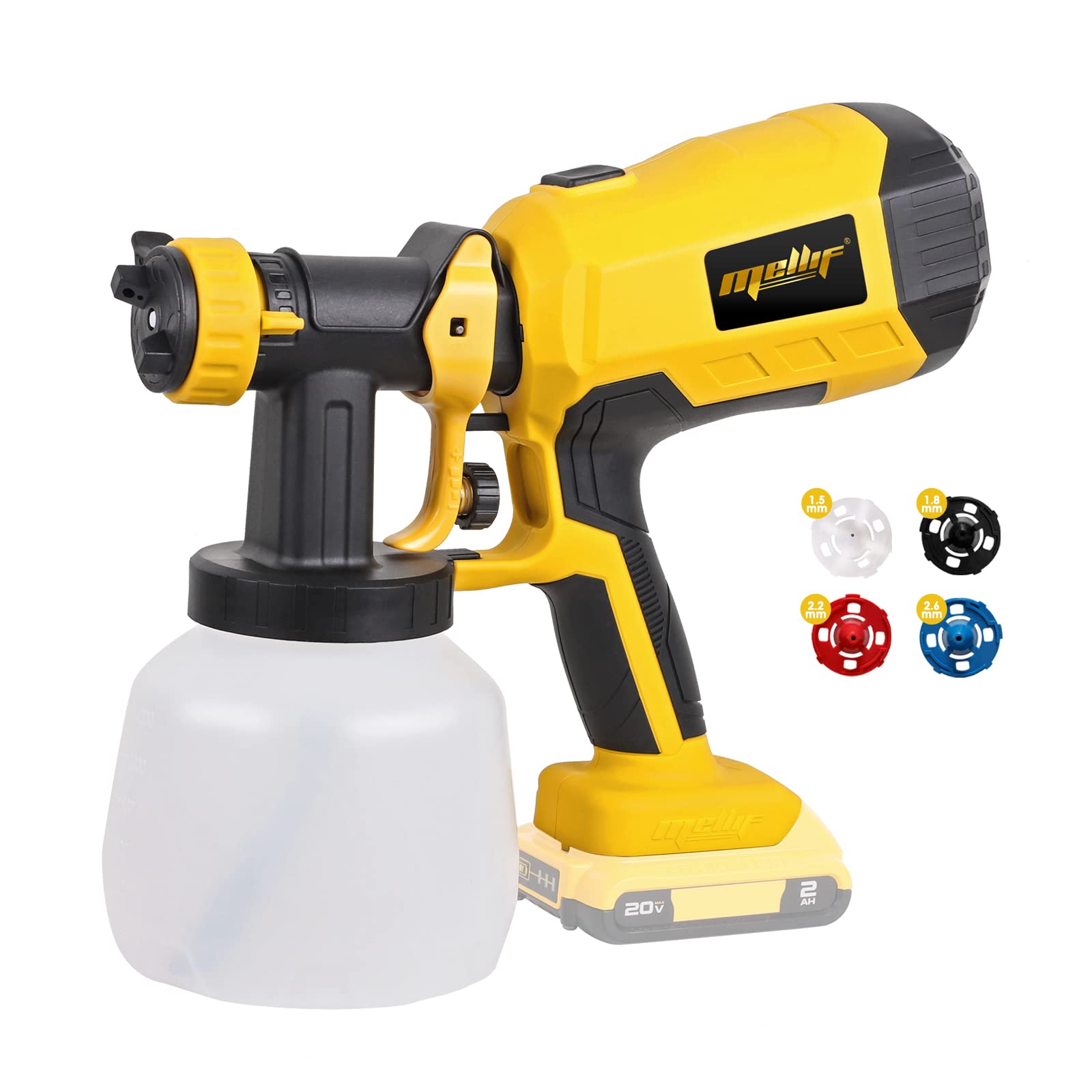
 Paint Sprayer Reviews & Buying Guides1 day ago
Paint Sprayer Reviews & Buying Guides1 day agoDEWALT 20V Cordless Paint Sprayer Review (2023)
-
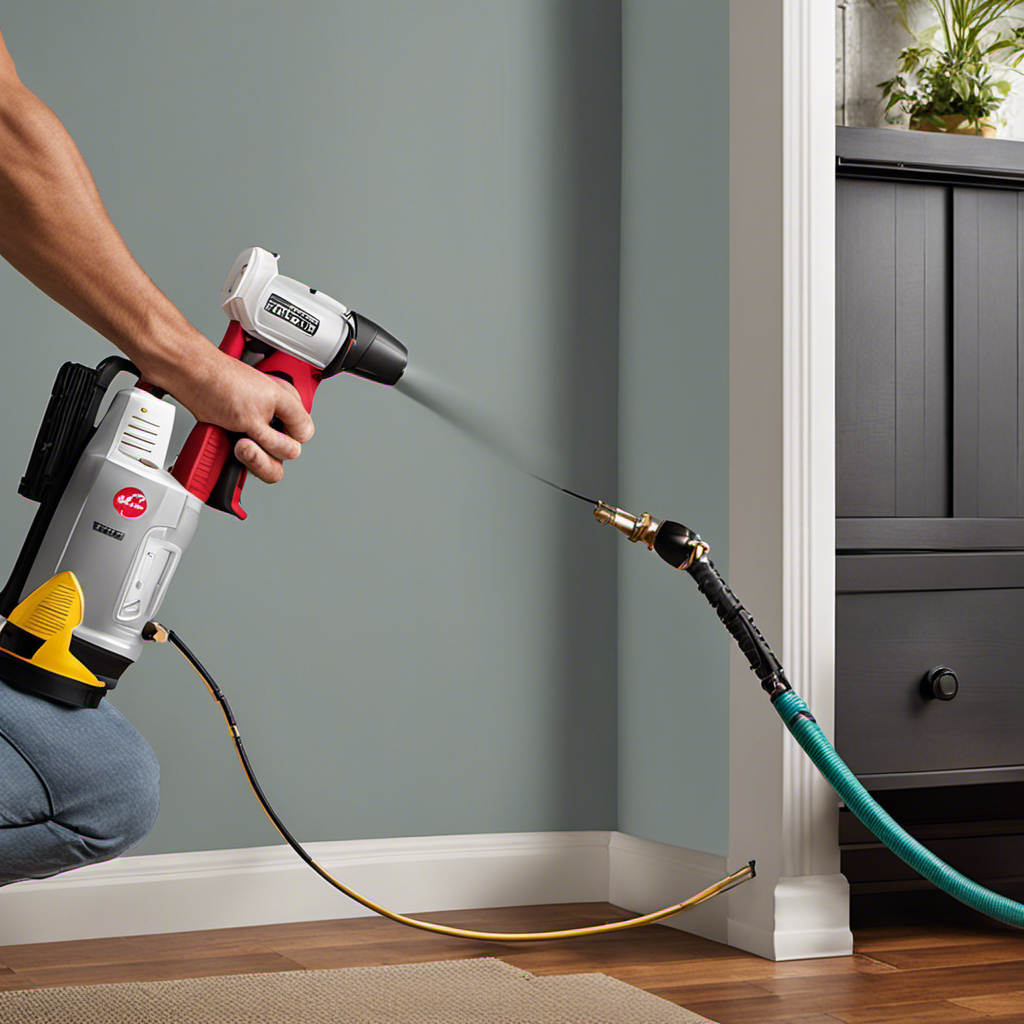
 Paint Sprayer Reviews & Buying Guides3 months ago
Paint Sprayer Reviews & Buying Guides3 months agoCalculating Paint Needs for Airless Sprayer: Coverage, Surfaces, and Tips (2023)
-
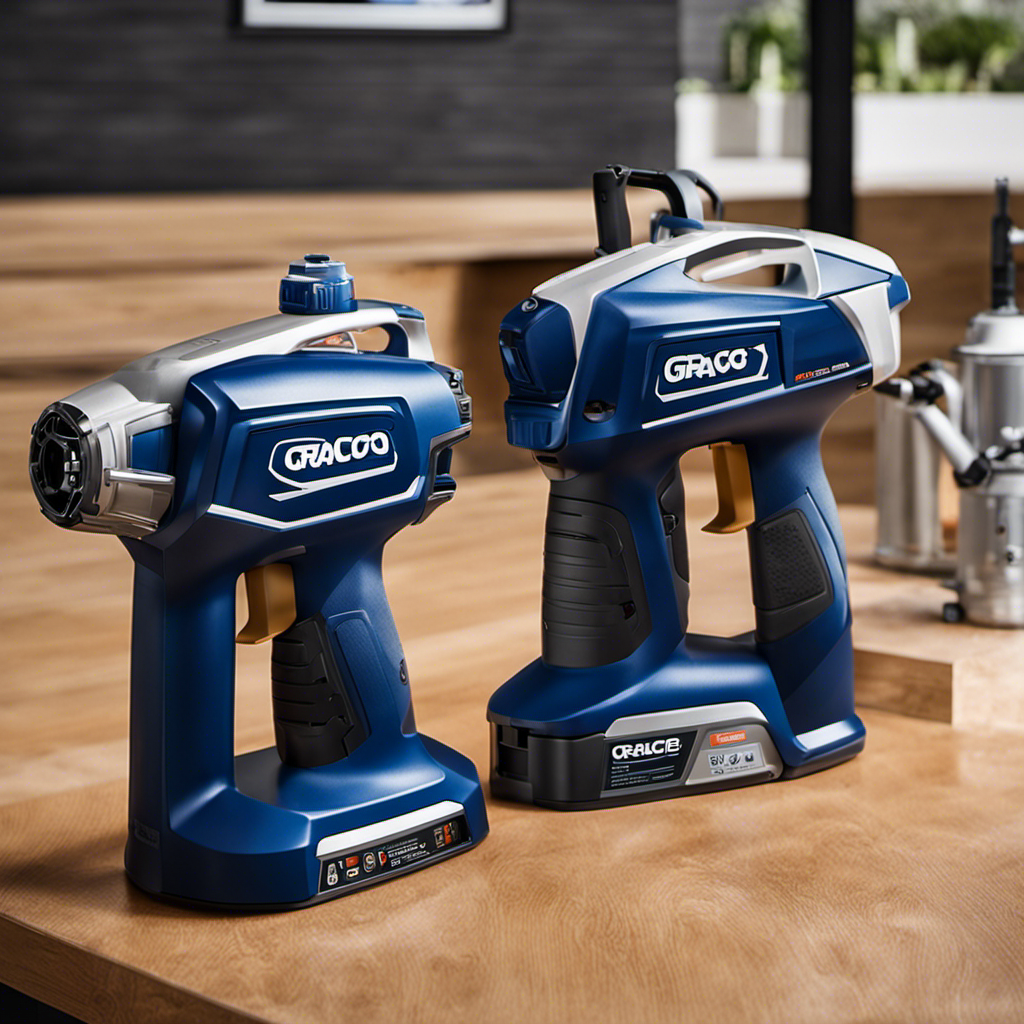
 Paint Sprayer Reviews & Buying Guides3 months ago
Paint Sprayer Reviews & Buying Guides3 months agoGraco Truecoat 360: DSP Vs VSP – a Comparison of Power and Portability (2023)
-

 How-To & Tips3 months ago
How-To & Tips3 months agoMastering the Avanti Airless Paint Sprayer: Tips and Techniques
-
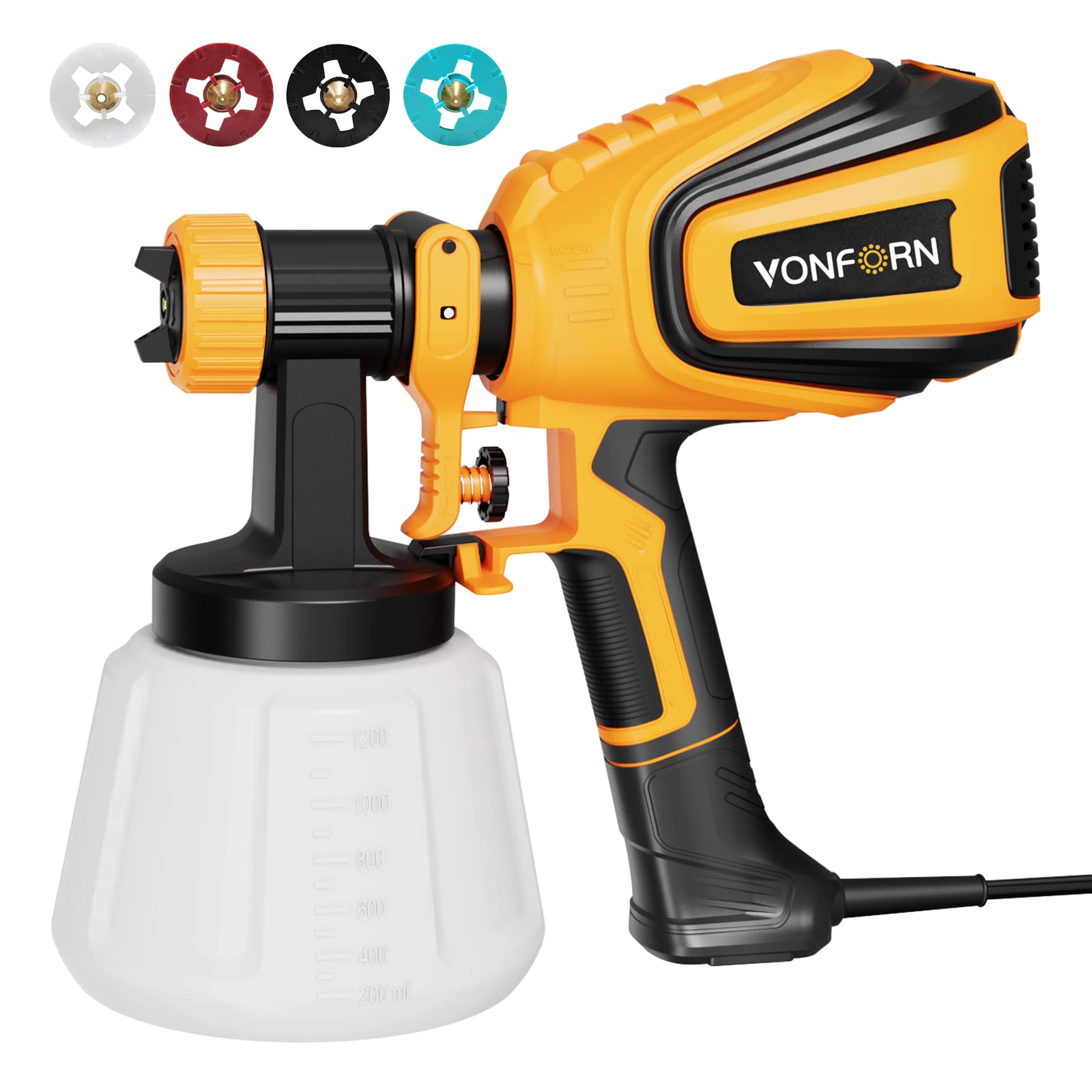
 Paint Sprayer Reviews & Buying Guides2 days ago
Paint Sprayer Reviews & Buying Guides2 days agoVONFORN Paint Sprayer Review: High Performance HVLP Spray Gun (2023)
-

 Paint Sprayer Reviews & Buying Guides1 week ago
Paint Sprayer Reviews & Buying Guides1 week agoSpray Painting Hazards: Safety Measures and Compliance (2023)
-
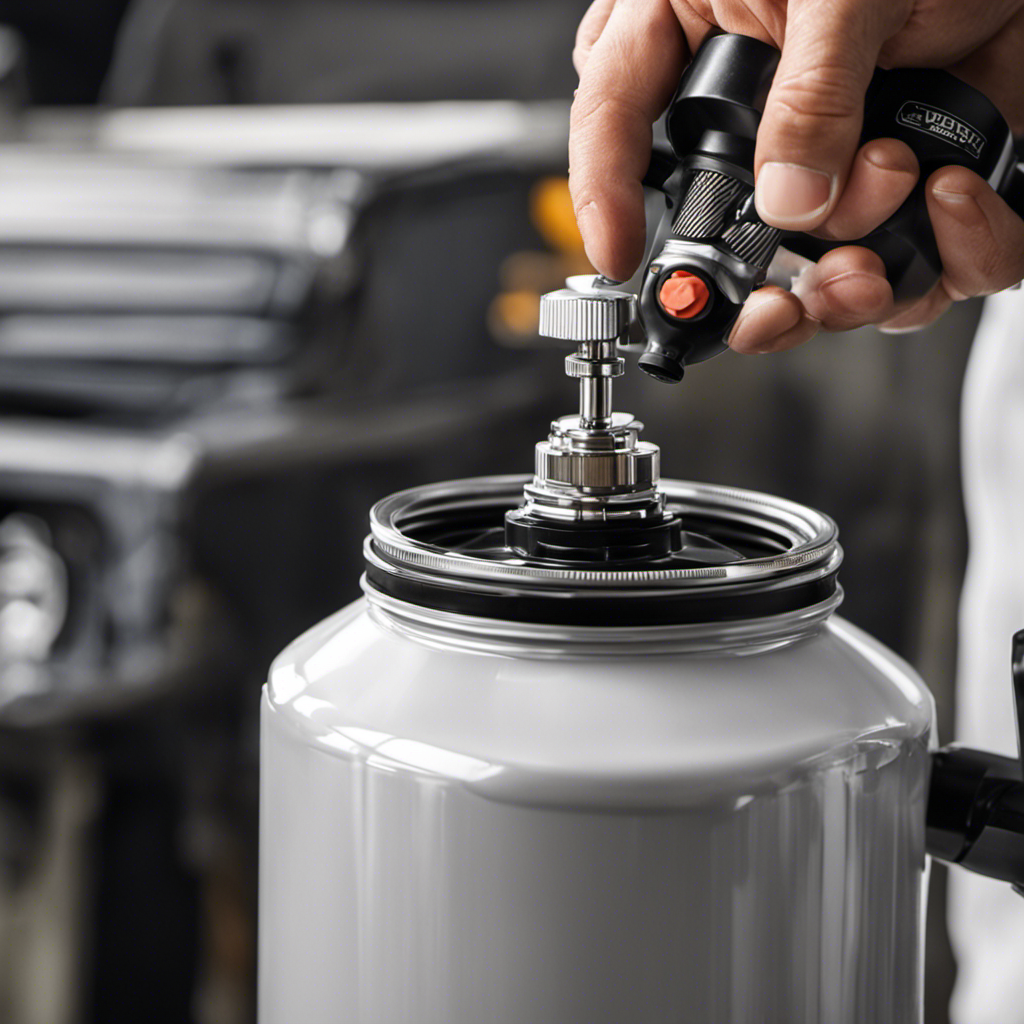
 Paint Sprayers FAQs3 days ago
Paint Sprayers FAQs3 days agoHow to Adjust Pressure on Airless Paint Sprayer
-
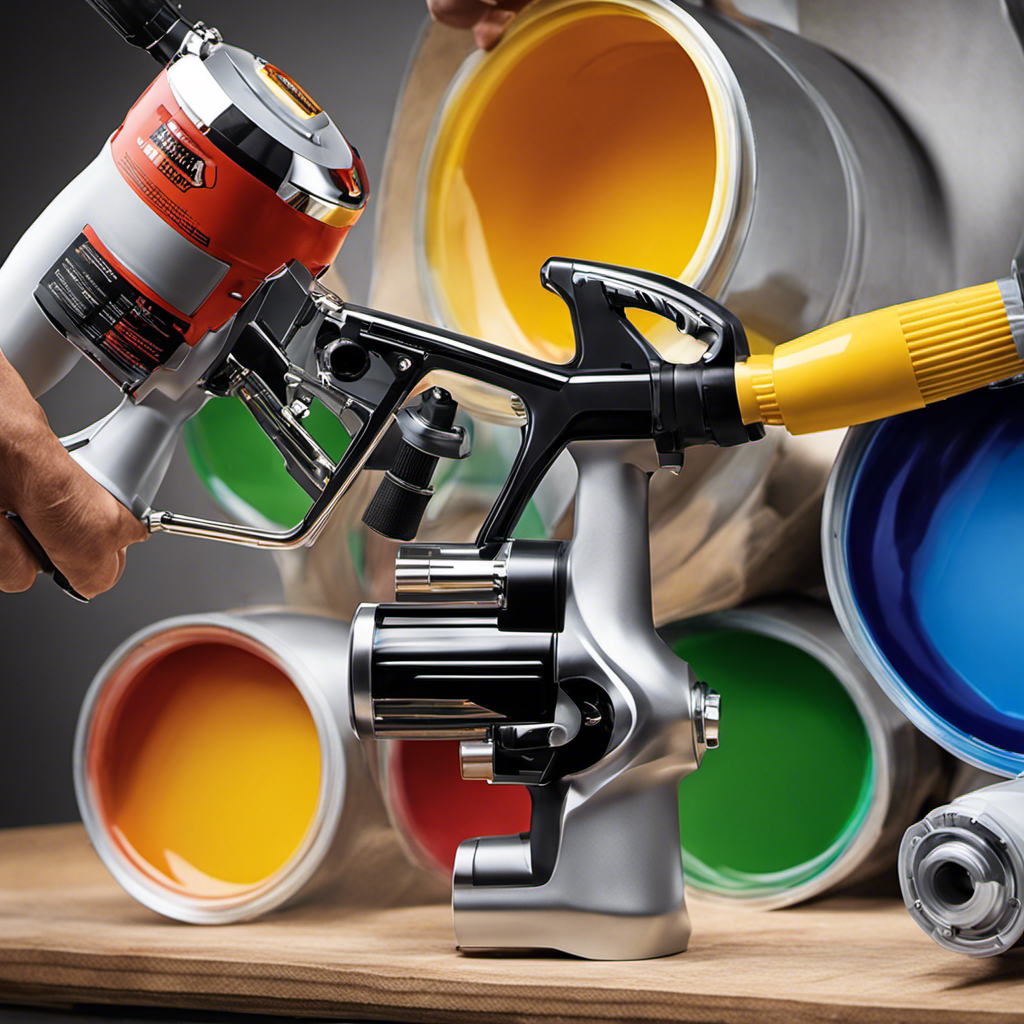
 Paint Sprayer Reviews & Buying Guides3 months ago
Paint Sprayer Reviews & Buying Guides3 months agoChoosing the Right Tip Size for Your Airless Paint Sprayer (2023)
